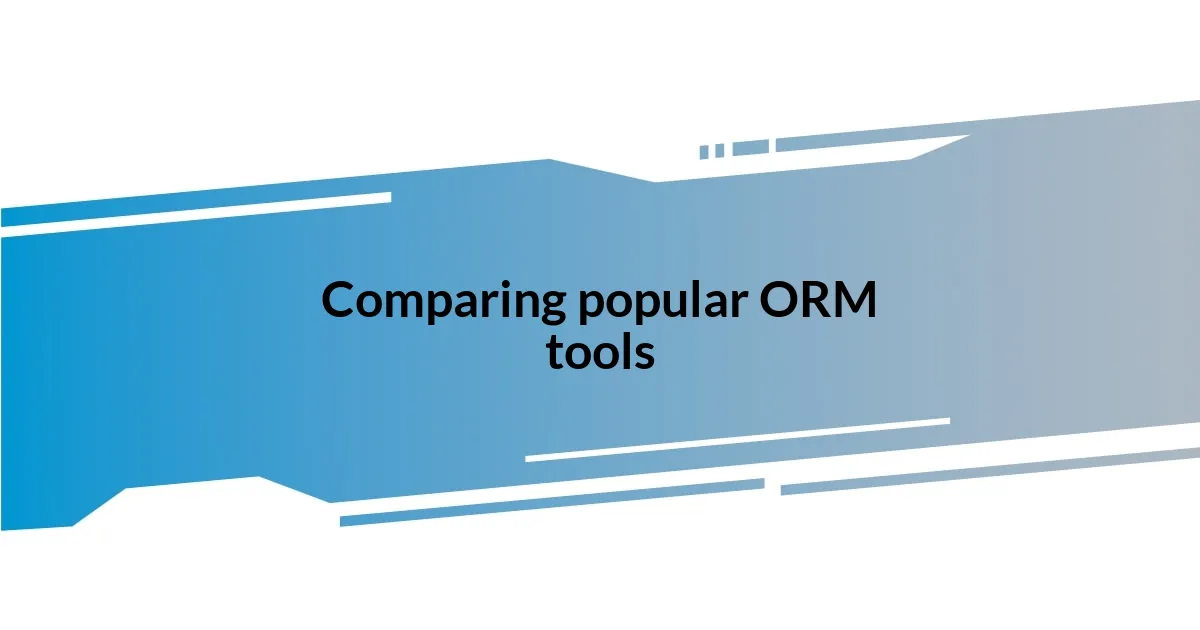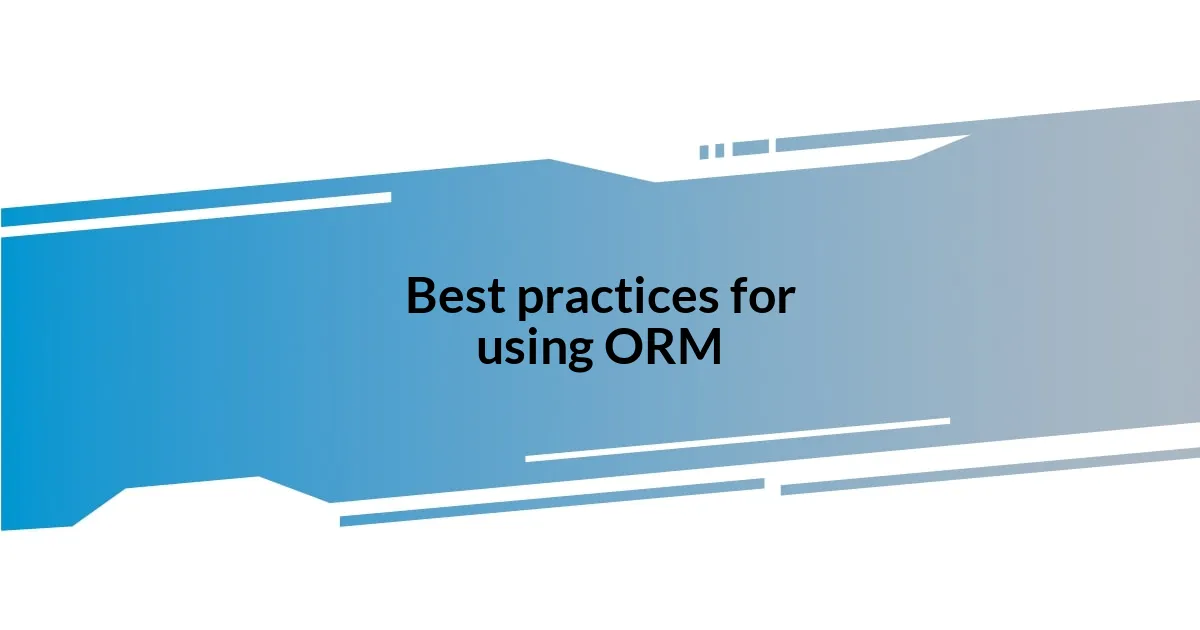Key takeaways:
- ORM tools bridge object-oriented programming and relational databases, simplifying database interactions through automatic data mapping and query generation.
- Popular ORM tools like Hibernate, Entity Framework, Sequelize, and Django ORM each offer unique strengths, with considerations for performance and usability.
- Implementing ORM effectively requires understanding database structures, optimizing data retrieval strategies, and leveraging community resources for support.
- Future trends in ORM technology include the integration of machine learning, support for microservices architecture, and an emphasis on enhancing developer experience.

Understanding ORM tools
ORM tools, or Object-Relational Mapping tools, serve as a bridge between the object-oriented programming world and relational databases. I remember my first encounter with ORM tools; it felt like magic when I realized I could interact with my database using simple objects rather than complex SQL queries. Have you ever found yourself wrestling with intricate database structures? ORM simplifies that process, making it accessible and more intuitive.
These tools encapsulate the mapping of object classes to database tables, allowing developers to work with data in a more natural way. For instance, when I transitioned a project from raw SQL to using an ORM tool, it was like lifting a heavy weight off my shoulders. It streamlined my code and reduced the likelihood of errors, freeing up my mental space to focus on building better features instead of getting bogged down by database intricacies.
However, it’s crucial to understand that ORM tools are not without their challenges. As I’ve learned, they may introduce performance overheads, particularly with complex queries. Have you ever noticed how a simple task can suddenly become sluggish under heavy data loads? Balancing convenience with performance requires a thoughtful approach, and staying mindful of these considerations can help ensure that ORM tools serve us well instead of hindering our progress.

Key features of ORM tools
Key features of ORM tools come together to provide a powerful toolkit for developers navigating databases. One key feature I particularly appreciate is the automatic data mapping. This means that when I create an object in my code, the ORM tool automatically translates it into a database record. This not only saves time but also minimizes the chances of mismapping data. I remember a project where I had to handle user data – the ability to simply define my class properties and watch them sync with the database was nothing short of a revelation.
Here are some other notable features of ORM tools:
- Query Generation: ORMs generate SQL queries behind the scenes, making it easier to retrieve or manipulate data without needing to write verbose SQL code.
- Caching: Many ORM tools incorporate caching mechanisms to improve performance and reduce database load for repeated queries.
- Transaction Management: They often include built-in transaction support, ensuring that operations can be completed in a reliable and error-free manner.
- Validation: Most ORM tools allow for validation rules to be applied to data entities, ensuring that only valid data is saved to the database.
- Migration Support: They typically offer tools to manage database schema changes, making it easier to evolve your database structure over time.
With these features, using ORM tools helps streamline my workflow, enhancing productivity while making it enjoyable to build applications. There’s something satisfying about transforming a complex project into something elegant and efficient, isn’t there?

Comparing popular ORM tools
When it comes to comparing popular ORM tools, each option has its strengths and weaknesses. For instance, I found that Hibernate, a widely used ORM in the Java ecosystem, boasts advanced caching and a robust querying language. However, its learning curve can feel steep, especially for newcomers. Conversely, I have enjoyed working with Entity Framework in .NET environments, as it offers seamless integration with Visual Studio. The speed at which I could set up a project with it was exhilarating, making database interactions feel almost effortless.
On the other hand, Sequelize, which I used with Node.js, impressed me with its flexibility and simple syntax. I vividly remember creating complex queries with just a few lines of code, a moment that truly highlighted the power of modern ORM tools. Still, some users struggle with its documentation, often raising questions like, “Why isn’t this working as I expected?” Incidents like these remind me of the importance of community support when choosing an ORM tool.
Finally, I can’t overlook Django’s ORM, which closely ties with the framework itself. My first experience with it was transformative; it made building a web application feel cohesive rather than fragmented. Yet, as with any tool, performance can vary depending on how one structures queries. I’ve learned that even the best ORM won’t save poorly optimized code, but knowing how these tools compare is essential to making the right choice for any project.
| ORM Tool | Key Features |
|---|---|
| Hibernate | Advanced caching, HQL, but steep learning curve |
| Entity Framework | Seamless Visual Studio integration, intuitive |
| Sequelize | Flexible, simple syntax, but sometimes confusing documentation |
| Django ORM | Integrated with Django framework, ease of use, performance issues possible |

Implementing ORM in projects
Implementing ORM tools in my projects has always felt like a breath of fresh air. I recall my first encounter with an ORM: it transformed a convoluted database interaction into an elegant process. I remember thinking, “How did I ever code without this?” The simplicity of defining models and interacting with them instead of wrestling with SQL queries was liberating.
As I dove deeper into implementation, I realized that understanding the underlying database structure was still critical. For example, while using Entity Framework, I often found that diving into the Code First approach allowed me to mold my database schema directly from my code. This experience taught me the importance of aligning object-oriented design with database design, making the implementation more intuitive.
One challenge I faced was the initial setup of the ORM. The documentation is crucial here; I’ve struggled with it before, so finding a solid resource can save hours of confusion. Have you ever felt that frustration when the documentation feels like it’s written in another language? I found that engaging with community forums or Stack Overflow often led to my “aha” moments, turning a daunting task into a manageable one. Consistently applying my learning has made implementing ORM tools not just easier but also an enjoyable part of the coding process.

Best practices for using ORM
When using ORM tools, one of the best practices I’ve discovered is always to be mindful of lazy vs. eager loading. I recall a project where I forgot to implement eager loading, and I was left with an avalanche of database queries that slowed down my application. It’s heartbreaking to see all that potential wasted simply because I didn’t optimize my data retrieval strategy. Have you ever fallen into that trap? Understanding the implications of these approaches not only enhances performance but also leads to better resource management.
Testing the performance of your ORM is another key practice I’ve embraced. When I started using Sequelize, I unknowingly loaded an entire dataset instead of paginating it. I remember the moment the application lagged; it was a wake-up call. Now, I regularly analyze the generated SQL queries and adjust them to fit my needs. By keeping a close eye on performance, I can ensure my application runs smoothly even as it scales up.
Lastly, leveraging the community and resources available around your ORM tool can be a game-changer. One time, I was stuck on an intricate query while using Hibernate, and browsing through forums led me to a relevant solution that I could have missed otherwise. Engaging with user groups not only provides immediate answers but also helps unravel deeper insights that can significantly improve my coding practices. Isn’t it refreshing to know that there’s a whole community out there ready to share their experiences with you?

Common pitfalls in ORM usage
There are several common pitfalls I’ve encountered while using ORM tools that can trip up even seasoned developers. One that stands out is the tendency to take the ORM at face value, forgetting that it’s merely an abstraction over SQL. I recall a particularly frustrating experience where I faced unexpected performance issues because I relied on the ORM to optimize queries for me without inspecting what was happening under the hood. Have you ever assumed everything was running smoothly, only to discover the database was overwhelmed with poorly structured queries?
Another pitfall is misunderstanding how transaction management works within an ORM framework. I once made the mistake of executing multiple operations without properly wrapping them in a transaction, leading to inconsistent data states. The sinking feeling of realizing I had introduced errors into my database was a hard lesson learned. Now, I make it a point to emphasize transaction boundaries in my projects. Have you ever faced a similar scenario? Taking the time to ensure that operations are atomic can save you from headaches later on.
Lastly, ignoring the ORM’s caching mechanisms has cost me dearly. I remember a project where I didn’t pay attention to how the ORM handled data caching and ended up with redundant queries that hobbled my app’s performance. It was disheartening to see how much faster everything could have been if I’d just leveraged caching correctly. The lesson here is clear: take the time to understand and utilize the caching capabilities; it can make a world of difference in the efficiency of your application. Do you take full advantage of caching, or do you find yourself grappling with unnecessary database loads?

Future trends in ORM technology
As I look ahead to the future of ORM technology, I’m particularly excited about the integration of machine learning into these tools. Imagine having an ORM that can predict your querying patterns and optimize them before you even realize you need it. I recall a time when I spent hours tweaking performance settings; if only an intelligent system could have streamlined that for me! Could you envision how much more efficient our workflows would become?
Another trend I see gaining momentum is the increasing adoption of microservices architecture. With ORM tools evolving to support distributed systems, it becomes essential to ensure data consistency across services. I think back to a project where my microservices struggled with data integrity due to improper ORM configurations, which turned the deployment process into a nightmare. Have you faced similar challenges? As the microservices landscape grows, I can only hope to embrace ORMs that simplify these complexities rather than adding to them.
Finally, the emphasis on developer experience is set to reshape ORM tools as we know them. I’ve often felt frustrated by steep learning curves or inconsistent documentation when diving into new tools. I can’t tell you how refreshing it would be to see ORMs focus on intuitive interfaces and comprehensive learning resources. Wouldn’t it be phenomenal to have tools that empower developers, rather than overwhelm them? The future, I believe, will bring us user-friendly solutions that prioritize both functionality and ease of use.